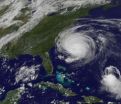(Press-News.org) The academic performance of adolescents will suffer in at least one of four key subjects –– English, math, science, history –– if their DNA contains one or more of three specific dopamine gene variations, according to a study led by renowned biosocial criminologist Kevin M. Beaver of The Florida State University.
The research sheds new light on the genetic components of academic performance during middle and high school, and on the interplay of specific genes and environmental factors such as peer behavior or school conditions.
"We believe that dopaminergic genes affect GPA because they have previously been linked to factors associated with academic performance, including adolescent delinquency, working memory, intelligence and cognitive abilities, and ADHD, among others," Beaver said. "So, the genetic effect would operate indirectly via these other correlates to GPA and school performance."
Findings from the study are described in a paper for which Beaver served as lead author that was published online Aug. 30 in the journal Intelligence. He and his coauthors performed their groundbreaking analysis using DNA and lifestyle data from a representative group of 2,500 U.S. middle- and high-school students who were tracked from 1994 to 2008 in the National Longitudinal Study of Adolescent Health.
"We found that as the number of certain dopaminergic gene variants increased, grade point averages decreased, and the difference was statistically significant," Beaver said. "For example, the GPA of a student with specific variants of three dopaminergic genes might be around 2.8, versus a GPA of around 3.3 without the variants. That could mean the difference between being accepted into a college versus being rejected.
"Unfortunately, we know that students with lower GPAs are generally more likely to participate in antisocial or criminal activities, and less likely to attend college and earn comparatively higher salaries as a result."
The researchers also uncovered a correlation between the variants of dopamine genes that a student possessed and his or her GPA in different subject areas.
For instance, they found a marginally significant negative effect on English grades for students with a single dopamine variant in a gene known as DAT1, but no apparent effect on math, history or science. In contrast, a variant in the DRD2 gene was correlated with a markedly negative effect on grades in all four subjects. Students with a single, DRD4 variant had significantly lower grades in English and math, but only marginally lower grades in history and science.
Previous, cutting-edge genetic research in biosocial criminology has revealed the mutual interdependence of genes and environment –– which means, said Beaver, that certain genetic factors may wield tangible effects when paired with certain environmental factors.
"It is quite likely that a similar feedback loop exists with GPA, whereby the genetic liability for low GPA could be moderated by environmental conditions such as school structural characteristics, teacher performance, or behavior of other students," he said.
"If that is true, then findings such as ours could help lead to more effective, innovative ways of enhancing school and individual performance."
INFORMATION:
The paper ("Three dopaminergic polymorphisms are associated with academic achievement in middle and high school") coauthored by Beaver and researchers at St. Louis University, Iowa State University, and the universities of North Carolina and Cincinnati can be accessed via the Science Direct website at www.sciencedirect.com/science/journal/01602896.
Beaver is an associate professor in the FSU College of Criminology and Criminal Justice and the coauthor of more than 100 published papers on the biosocial underpinnings of antisocial and criminal behavior. To date, his body of research includes work that links the use of steroids to "roid rage" and genetics to adolescent victimization, formation of delinquent peer groups, and gun violence among gang members –– all among the first such works in the field of biosocial criminology. He won the American Society of Criminology's 2009 Ruth Shonle Cavan Young Scholar Award, in recognition of his outstanding scholarly contributions. Beaver is the coauthor/editor of "Biosocial Criminology: A Primer" (Kendall/Hunt, 2009) and six other books.
Learn more about The Florida State University's distinguished College of Criminology and Criminal Justice at www.criminology.fsu.edu/.
Low grades in adolescence linked to dopamine genes
Florida State criminologist leads analysis of genetics' impact on academic success
2010-09-04
ELSE PRESS RELEASES FROM THIS DATE:
GEN reports on the greening of the life sciences
2010-09-04
New Rochelle, NY, September 1, 2010—Biopharmaceutical firms and other life science organizations are taking definitive steps toward creating greener working environments and developing more sustainable operations, reports Genetic Engineering & Biotechnology News (GEN). This promising trend was made clear through a series of presentations and panel discussions that took place at GEN's (www.genengnews.com/gen-articles/biopharma-s-going-green/3381), "GreenBioPharma" conference, which was recently held in Philadelphia.
"The main message that emerged from our meeting was that ...
Sight-saving research halted by stem cell ruling
2010-09-04
The Association for Research in Vision and Ophthalmology (ARVO), a professional organization of member scientists, opposes the Federal District Court injunction that froze federal funding for human embryonic stem cell (hESC) research. ARVO is troubled by this barrier to research that has the potential to restore sight and mitigate eye damage.
ARVO members investigate hESC therapies for treating diseases such as age-related macular degeneration (AMD), diabetic retinopathy, glaucoma and corneal disease, along with studies related to eye tissue transplantation, regeneration ...
Scientists identify molecules involved in touch and other mechanically activated systems
2010-09-04
LA JOLLA, CA – September 2, 2010 – Scripps Research Institute scientists have identified two proteins with potential to be important targets for research into a wide range of health problems, including pain, deafness, and cardiac and kidney dysfunction.
The study was published in Science Express, the advanced, online edition of the journal Science, on September 2, 2010.
In the study, the Scripps Research scientists identify two proteins, which they named Piezo1 and Piezo2 from the Greek meaning "pressure," involved in the cellular response to mechanical stimulation. ...
Test-tube calf embryos more likely to survive Texas summers
2010-09-04
Studies have shown that heat-stressed dairy cows suffer from damage to their ovarian follicles. Moreover, the eggs produced by the damaged follicles may also be damaged, said Dr. Todd Bilby, Texas AgriLife Extension Service dairy specialist.
Worse, after becoming heat-stressed, other studies have shown the eggs she ovulates for the next 40 or 50 days are likely to be damaged as well, according to Bilby.
Bilby and his graduate student, Brandi Stewart, have found a way to double pregnancy rates during the summer and increase the number of heifers born as compared with ...
Caltech chemists develop simple technique to visualize atomic-scale structures
2010-09-04
PASADENA, Calif.—Researchers at the California Institute of Technology (Caltech) have devised a new technique—using a sheet of carbon just one atom thick—to visualize the structure of molecules. The technique, which was used to obtain the first direct images of how water coats surfaces at room temperature, can also be used to image a potentially unlimited number of other molecules, including antibodies and other biomolecules.
A paper describing the method and the studies of water layers appears in the September 3 issue of the journal Science.
"Almost all surfaces have ...
LSUHSC pediatric weight expert provides obesity trinity answers
2010-09-04
New Orleans, LA – In a first person paper published in the August 27, 2010 issue of Childhood Obesity, Dr. Melinda Sothern, Director of Health Promotion and Professor of Public Health at LSU Health Sciences Center New Orleans, provides three ways to de-program the 1950s obesity trinity underlying the current obesity epidemic in the United States and protect future generations from its health consequences.
"The combination of prenatal tobacco use, infant formula, and frequent pregnancies—
i.e., the obesity trinity—synergistically created the first generation of nutritionally ...
UCSF unveils model for implantable artificial kidney to replace dialysis
2010-09-04
UCSF researchers today unveiled a prototype model of the first implantable artificial kidney, in a development that one day could eliminate the need for dialysis.
The device, which would include thousands of microscopic filters as well as a bioreactor to mimic the metabolic and water-balancing roles of a real kidney, is being developed in a collaborative effort by engineers, biologists and physicians nationwide, led by Shuvo Roy, PhD, in the UCSF Department of Bioengineering and Therapeutic Sciences.
The treatment has been proven to work for the sickest patients using ...
NASA catches heavy rainfall happening in Category 4 Earl as it approaches the US
2010-09-04
Hurricane Earl is still a powerful category four hurricane on the Saffir-Simpson Scale as it approaches the North Carolina coast today. NASA's Tropical Rainfall Measuring Mission (TRMM) satellite observed the high rates rain was falling within Earl, in some areas more than 2 inches per hour. Today, the Global Hawk unmanned aircraft is also flying into the eye of Hurricane Earl at altitudes of 60,000 feet to gather information about the storm.
Hurricane Earl became the most powerful hurricane of the 2010 Atlantic season early on September 2 when its sustained winds reached ...
Laser-based missile defense for helicopters being developed
2010-09-04
ANN ARBOR, Mich.---Protecting helicopters in combat from heat-seeking missiles is the goal of new laser technology created at the University of Michigan and Omni Sciences, Inc., which is a U-M spin-off company.
"Battlefield terrain in places like Afghanistan and Iraq can be so rough that our troops have often had to rely on helicopters, and they can be easy targets for enemies with shoulder-launched missiles," said Mohammed Islam, a professor in the Department of Electrical Engineering and Computer Science.
"Our lasers give off a signal that's like throwing sand in ...
Bermuda in warnings as the GOES-13 Satellite catches Fiona approaching
2010-09-04
Bermuda has warnings up as Tropical Storm Fiona approaches, and GOES-13 satellite imagery from today shows that Fiona, although packing a punch, is a much smaller system that her brother, the Category 4 Hurricane Earl.
A tropical storm warning is in effect for Bermuda today, Sept. 2, as tropical storm force winds are expected there by late Friday. Bermuda can expect between 1 to 3 inches of rainfall from Fiona.
When the Geostationary Operational Environmental Satellite called GOES-13 captured a visible image of Tropical Storm Fiona approaching Bermuda this afternoon ...
LAST 30 PRESS RELEASES:
Bottleneck in hydrogen distribution jeopardises billions in clean energy
Lung cancer death rates among women in Europe are finally levelling off
Scientists trace microplastics in fertilizer from fields to the beach
The Lancet Obstetrics, Gynecology, & Women’s Health: Taking paracetamol during pregnancy does not increase risk of autism, ADHD or intellectual disabilities, confirms new gold-standard evidence review
Taking paracetamol during pregnancy does not increase risk of autism, ADHD or intellectual disabilities
Harm reduction vending machines in New York State expand access to overdose treatment and drug test strips, UB studies confirm
University of Phoenix releases white paper on Credit for Prior Learning as a catalyst for internal mobility and retention
Canada losing track of salmon health as climate and industrial threats mount
Molecular sieve-confined Pt-FeOx catalysts achieve highly efficient reversible hydrogen cycle of methylcyclohexane-toluene
Investment in farm productivity tools key to reducing greenhouse gas
New review highlights electrochemical pathways to recover uranium from wastewater and seawater
Hidden pollutants in shale gas development raise environmental concerns, new review finds
Discarded cigarette butts transformed into high performance energy storage materials
Researchers highlight role of alternative RNA splicing in schizophrenia
NTU Singapore scientists find new way to disarm antibiotic-resistant bacteria and restore healing in chronic wounds
Research suggests nationwide racial bias in media reporting on gun violence
Revealing the cell’s nanocourier at work
Health impacts of nursing home staffing
Public views about opioid overdose and people with opioid use disorder
Age-related changes in sperm DNA may play a role in autism risk
Ambitious model fails to explain near-death experiences, experts say
Multifaceted effects of inward foreign direct investment on new venture creation
Exploring mutations that spontaneously switch on a key brain cell receptor
Two-step genome editing enables the creation of full-length humanized mouse models
Pusan National University researchers develop light-activated tissue adhesive patch for rapid, watertight neurosurgical sealing
Study finds so-called super agers tend to have at least two key genetic advantages
Brain stimulation device cleared for ADHD in the US is overall safe but ineffective
Scientists discover natural ‘brake’ that could stop harmful inflammation
Tougher solid electrolyte advances long-sought lithium metal batteries
Experts provide policy roadmap to reduce dementia risk
[Press-News.org] Low grades in adolescence linked to dopamine genesFlorida State criminologist leads analysis of genetics' impact on academic success




